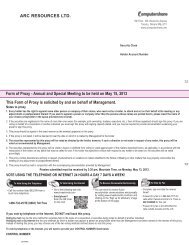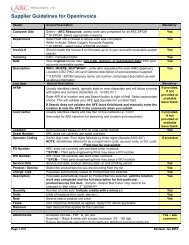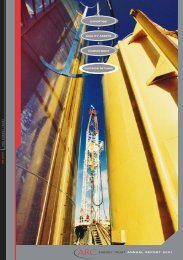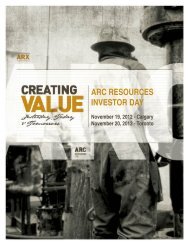Our corporate responsibility. - ARC Resources Ltd.
Our corporate responsibility. - ARC Resources Ltd.
Our corporate responsibility. - ARC Resources Ltd.
- No tags were found...
Create successful ePaper yourself
Turn your PDF publications into a flip-book with our unique Google optimized e-Paper software.
Greenhouse Gas Emissions8000007000006000005000004000003000002000001000000.130.1905 06 070.19 0.200.150.100.05GHG intensity (tonnes/m 3 OE)Greenhouse Gas Emissions(CO 2 e tonnes/year)Note: The increase in the 2006 GHG was aresult of the December 2005 acquisition ofRedwater and NPCU.SO 2(tonnes)Benzene(tonnes)Gas flared& Vented(10 3 m 3 /yr)Solution GasConservationRate (%)Air Emissions05 06 072,381 2,461 2,7734.7 5.4 2.513,919 23,132 16,74095.4 94.7 97.7<strong>Our</strong> Management ApproachTo consistently live up to our commitments, we have been developing a robust environmentalmanagement system that comprises the following elements:• an environmental policy• annual goals and objectives• regular auditing, and• quarterly reporting to the HSE Committee of the Board of DirectorsWe strive to continually improve our environmental management system to ensure that emergingtrends, new technology, and government regulations are fully in<strong>corporate</strong>d.We have a <strong>corporate</strong> HSE group that develops operating practices and procedures with HSECo-ordinators located at our field offices. Together we ensure that a consistent environmentalmanagement process is executed through the company.Managing Greenhouse Gas EmissionsFor any oil and gas company, reducing greenhouse gas (GHG) emissions is a considerable challenge.For <strong>ARC</strong>, it is a challenge we are addressing strategically and aggressively.<strong>ARC</strong> has intentionally acquired oil reservoirs that we believe are prime candidates for enhanced oilrecovery through the injection of carbon dioxide (CO 2). If CO 2is captured from large sources and madeavailable to us, we could sequester large amounts of carbon in our reservoirs, thereby reducing theamount of CO 2emitted into the atmosphere and increasing ultimate oil recovery. Currently there areno large quantities of CO 2being captured by emitters.Depending on what happens with carbon trading mechanisms in Canada and on availability of CO 2that would otherwise be emitted to the atmosphere, we could end up with significant carbon credits,as we expect to be able to sequester perhaps as much as 10,000 to 20,000 tonnes of C0 2per day.This is equivalent to removing 2,000 to 4,000 vehicles from the roads daily (and over one millionvehicles annually). In July 2008, <strong>ARC</strong> commenced a pilot C0 2injection project in the Redwater area.Midway through 2007 <strong>ARC</strong> began the first phase of implementing a fugitive emission managementprogram that will help us monitor and manage our fugitive emissions. We believe this programpresents an opportunity to make emission reductions that would not otherwise occur. The programwill continue through 2009 at which time we will assess the benefits of continued fugitiveemission monitoring. Fugitive emissions are air pollutant releases not confined to a stack, duct, vent,tank or other identified sources.Current Alberta greenhouse gas regulations do not significantly affect <strong>ARC</strong> since we do not operateany facilities that qualify as a large final emitter. However, <strong>ARC</strong> does have an interest in 34 facilitiesthat exceed the 3,000 tonnes per year Federal guideline. Subject to elaboration of the full federalguidelines, the impact on <strong>ARC</strong>’s operations is minimal at this time. We are continuously working onimproving our data management processes in order to obtain consistent, accurate, and verifiabledata. We feel the benefits associated with quality data management will become increasingly valuableas the regulatory environment clarifies and strengthens.Managing Obligations<strong>ARC</strong> actively reclaims abandoned oil and gas leases and roads. This involves returning our sites to astate equivalent to conditions prior to disturbance. We actively use soil treatment facilities ratherthan land farming techniques or landfills. This allows us to return native soils during the reclamationprocess. We have recently received approval for, and built, a bio-remediation facility in the Redwaterfield to facilitate the treatment of hydrocarbon contaminated soils in the Redwater area.10 2Corporate Responsibility








